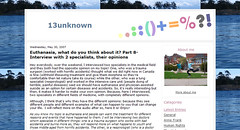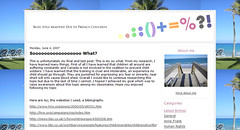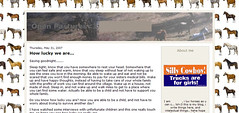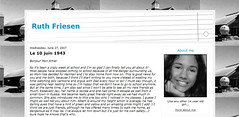21Classes and Personalized Spaces
This past term, my students and I used a new blogging platform called 21Classes. One of its most appealing features is the fact that, as a community, our class had its own blog portal - one communal page that displays all the most recent posts and comments. This home page is a kind of aggregator which can be set to display static information posted by the teacher as well as non-static items such as the following:
We did not use all of the above but the ones that we did use helped in two significant ways. First of all, they made it easier to navigate around the online community by displaying links to all student blogs and to the most frequently discussed entries. Secondly, they also helped create a sense of community among the students by making all contributions (posts, comments, photos) clearly visible. It helped the students see the global progress of the community and their own place within it.
One of the most valuable features of this platform, however, turned out to be the ability to personalize the look of each individual blog.
For the very first time since I started using blogs in my classes (over three years ago), the platform I chose allowed my students to customize the look of their individual blogs. The software I used before (Manila, LifeType) allowed users to change the themes (I had to upload them first in order to make them available to my students) but did not give my students the freedom to personalize any of the specific aspects of each theme, such as the blog header, the background, or the colour and size of the font.
Unlike the other software we used in the past, 21classes allows every blogger to modify the background, the header, and the colour and size of all fonts - practically every little detail of one’s blog. The students can also choose from a variety of different widgets that can be embedded in the blog’s side panels (Calendar, About Me, My Favourite Blogs, Most Recent Comments, etc.).
So What?
As administrator of our 21classes.com portal, I was able to give my students the opportunity to pick a theme and then modify it. At the beginning of the term, when I gave them one class to get to know the community and the software, the students used it to learn how to modify their blogs. These are some of the questions and conversations that I overheard and jotted down:
How do you change the title? You mean the header? Yeah. That top banner.
How did you change your background to yellow? You can upload a picture, too. See?
Can you change the size of the font? Where? In my title. Sure. You can change the colours, too. Just pick a theme and then click on it. That opens a new page … here I’ll show you.
Look at …’s blog. She changed the borders. How do you do that?
In other words, they spent one hour and then also some time at home learning how to personalize their blogs. Most of them kept the same theme and modifications throughout the term. Some made minor changes on a regular basis.
Why is this important? I believe that the effort they had put forth to personalize their spaces contributed greatly to their sense of ownership and involvement as writers. Initially, I was concerned that this would lead to an undue preoccupation with the visual appeal of their blogs and distract them from the focus of our blogging community - writing and research. It didn’t. The students seemed aware of the fact that the visual appeal of the blog, no matter how inspiring, would not ensure readership. They knew that conversations emerge from interactions with and about texts.
The ability to create a virtual space that is uniquely one’s own turned out to be much more important than I had anticipated. It helped the students define themselves as individuals, not pupils who use a teacher-sanctioned tool to post work. When I compare student blogs from two years ago or from last year to the personalized blogs that the students created with 21Classes, I see a collection of individuals, not a classroom. I see evidence of personal engagement but no evidence of an institutional setting. The uniformity that the other platforms forced upon us was gone and what emerged was a creative and engaging mosaic. Take a look:
Some of the students modified their blogs to reflect the focus of their research, not their personalities. Take a look at the following examples (move your mouse over the photo to see explanatory notes on my Flickr site):
Blogging is about personal expression. The ability to personalize one’s space is something that needs to be an integral part of every community. I believe that it is an important building block that can help us build communities with our students. If a blogging community focuses primarily on creation then why not start by creating one’s space, one’s atelier where the process of creation will take place?
This reminds me of John Dewey’s statement that the self depends for its wholeness upon its surroundings (Art as Experience). In other words, what impacts the work of every individual blogger is not just the community itself or the connections made in the World Wide Web but also the immediate environment where he or she creates and “resides.” This immediate environment also allows students to become emotionally attached to their spaces. Without that involvement, Dewey argues, there can only be craftsmanship and not art. In other words, a blog I cannot personalize is a place where I have no control and no personal investment. This will greatly limit my ability to engage as an individual.
Perhaps I’m exaggerating but it seems to me that it is important to use a blogging tool that allows students to redefine their spaces as other than strictly academic sites of engagement. I have spent quite a bit of time looking at the screenshots above and have come to the conclusion that, for the most part, they do not look like school writing journals. Yes, you can see that the students are clearly engaged in school work and that there are certain elements that make these blogs similar (the “About Me” page or the link to the home page of our community), but there is also a lot of individuality in each blog. There is evidence of personal and creative engagement. These are (or have the potential to become) out-of-school learning spaces and not just school journals.
Of course, one can argue that it is all about contributions and ideas, not visual appeal. I agree. At the same time, I think it is crucial to allow all participants to create sites of inquiry that are uniquely their own. To some, this might mean using widgets. Others might choose to modify the header or font size. Whatever it is, as teachers we need to remember that it all starts with freedom - this is not just about creativity but also about stretching the boundaries and the control that characterize institutional settings.
I want my students to be able to say “This is where I write about things that I am interested in,” not “This is my school blog.” In other words, perhaps it’s time to liberate my students from the mindset of uniformity imposed upon me by the school and, instead of telling them to come to an online place that I have chosen, ask them to give me addresses of their own electronic spaces. Instead of saying, “Bookmark this URL, this is where all our blogs are going to be,” I could say, “Give me all your URLs - flickr, facebook, myspace, blogger - wherever you are - so that I can put them into one OPML file for all of us to share.”
I realize that due to various institutional constraints, many of us may not be able to use that approach for a very long time. Giving our students the freedom to build their own spaces, even within a teacher-sanctioned portal, is a good start.







